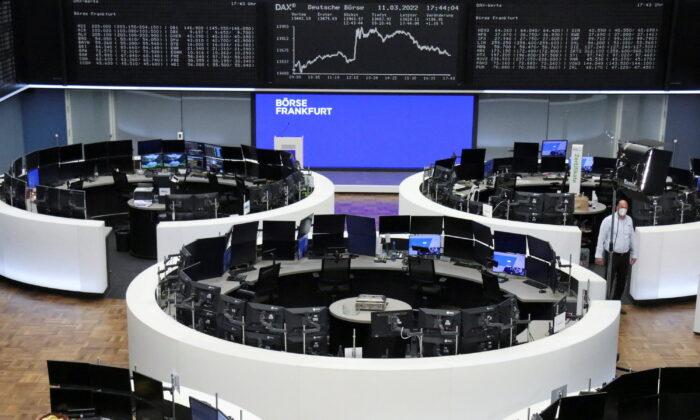LONDON—Global equity markets made a cautious start on Monday amid talk of more sanctions against Russia over its invasion of Ukraine, while a closely watched part of the U.S. yield curve fuelled recession worries further.
Germany said the West would agree to impose more sanctions on Russia in the coming days after Ukraine accused Russian forces of war crimes following civilian deaths near Kyiv.
More sanctions would ratchet up the already vast economic pressure on Russia following the conflict in Ukraine.
“I think that’s the key driver over the near term what happens with the sanctions if they peak here or not,” said Mark Haefele, chief investment officer at UBS Global Wealth Management.
The pan-European STOXX 600 was flat an hour and a half after the open while S&P 500 and Nasdaq stock futures were down about 0.1 percent.
Earlier, MSCI’s broadest index of Asia-Pacific shares outside Japan inched up 1 percent while markets in mainland China were closed for a holiday.
Haefele said a rebound in stock markets last week was driven by the fact that investors had little alternatives to buying equities.
Germany’s defense minister said the European Union must discuss banning imports of Russian gas, a step that would most likely send prices higher still.
Oil rose above $105 a barrel on Monday as concern about tight supply arising from the war in Ukraine and the lack of an Iranian nuclear deal persisted despite countries releasing oil from strategic reserves.
Last week oil prices slid 13 percent, their biggest weekly fall in two years, after President Joe Biden announced the largest-ever U.S. oil reserves release.
Meanwhile across fixed income markets, the yield curve between two-year and 10-year U.S. notes, widely seen as a signal of incoming economic contraction, stood inverted as a strong jobs report for March last week supported the view that the Federal Reserve would aggressively hike rates to tame soaring inflation.
Several Fed officials are due to speak at public events this week, with the prospect of sending more hawkish signals, and minutes of the last policy meeting are due on Wednesday.
Two-year yields were at 2.44 percent, close to their highest since March 2019 while benchmark 10-year yields stood at 2.38 percent.
The dollar index was last flat at 98.59, having recently bounced around between 97.681 and 99.377.
The recent jump in U.S. bond yields has backed the U.S. dollar, particularly against the yen, given the Bank of Japan acted repeatedly last week to keep its bond yields near zero.
The dollar was trading firm at 122.60 yen and not far from its recent seven-year peak of 125.10.
The euro eased 0.1 percent to $1.1037 while analysts fear the currency could fall further should the European Union ramp up its sanctions to target energy imports from Russia.






Friends Read Free